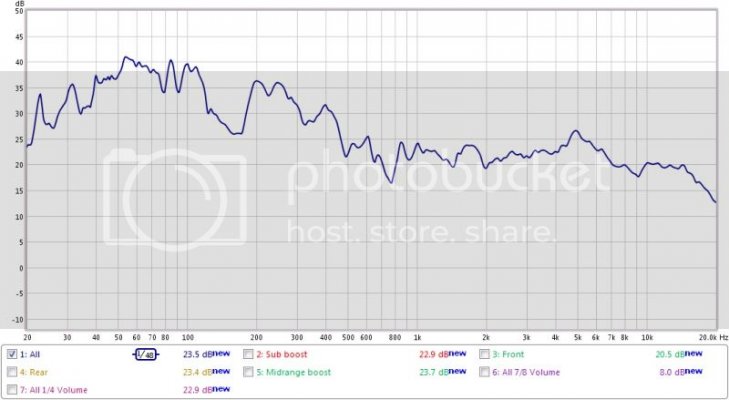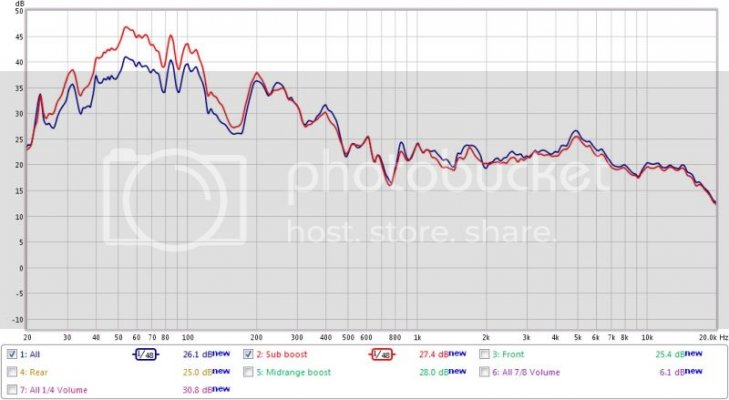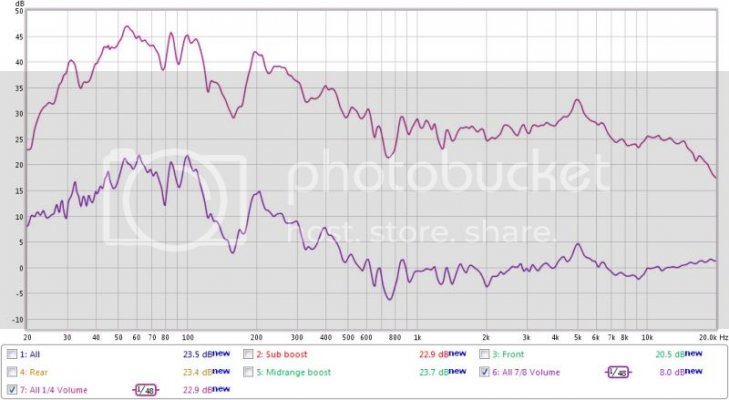not yet. we wanted to get the actual output going to the speakers with no interference. as i continue this thread, there will be more testing done. most likely i wont be able to do much until after my texas trip.I see a lot of variation from the factory head unit and amplifier going to the speakers for what should be a flat signal, however have you taken an RTA reading of in vehicle response at the drivers headrest?
You are using an out of date browser. It may not display this or other websites correctly.
You should upgrade or use an alternative browser.
You should upgrade or use an alternative browser.
Your Raptors Audio System
- Thread starter The Car Stereo Company
- Start date
Disclaimer: Links on this page pointing to Amazon, eBay and other sites may include affiliate code. If you click them and make a purchase, we may earn a small commission.
I have taken measurements of a new 2014 Ford Raptor, and the results were quite revealing. All measurements were taken from the drivers headrest, averaging about 75 measurements together for each final measurement. The Dayton UMM-6 Calibrated microphone was used for all information gathered.
For reference, 1 decibel is the smallest difference perceivable by the human ears, or the "JND", Just Noticeable Difference. A 3 decibel difference is readily able to hear, and 10 decibels is generally regarded as twice (or half) as loud. A 5db difference in sound is a pretty good jump, and not something you want a variation of that much in a stereo system for like frequencies. You do want stronger bass, from 20-50 should be relatively flat, then tapered down to about 200hz or so, then flat from about 200 to 3k-4khz, then a gradual taper down to 20khz.
The first picture is all speakers playing, and each horizontal line in the picture represents a 5 decibel difference, or a pretty good jump.

When we look at the picture, it does follow the general guidelines overall, but in the loosest sense of the term. the 20-50hz area is lacking, a giant dip from 100-200hz (this area gives you that "crunch" from guitars and the like), although dips are less noticeable than peaks, this is a huge dip. Again, from what we are looking for, you could also consider from 200-400hz a pretty good size peak. From 400-4k isn't completely terrible, but still lots of variations, and there is a 4.5db peak around 5khz, this will cause fatiguing and a "ringing" sensation when listening at loud volumes, then from 6.3k to 20k isn't terrible.
Besides a total lack of tonality, the amount of definition in music reproduction is quite horrible. I have heard better definition out of 5 dollar mids, no joke.
This next picture shows what the bass boost is doing, it's not really adding bass so much as mid-bass, from about 40hz to 160hz.

This next picture is quite interesting, as it shows that the bass and tweeters are attenuated at loud volumes, which I find interesting. It could be the fletcher munson curve being applied as the volume is adjusted, but I'm not sure I want to give them that much credit as it doesn't look proper. This is more likely due to Ford wanting to protect their speakers as they don't (probably rightly) trust their customers to not blow their speakers, especially when most people just boost eq bands, instead of cutting them, leading to lots of problems.

This next photo shows what the front vs rear stage is is doing. The rear is mostly there for rear fill, nothing much. Personally, I don't run any rear speakers and focus on getting the best sound out of the front that I can, and being in such a small space, the passengers in the rear of the truck aren't missing anything.
As far as processors go, the Mosconi 6to8 is nice, however, I prefer the interface and adaptability of the Rockford 360.3 (Center channel capable, if you wanted to keep your center channel speaker on the dash). The 360.3 will also "normalize" all of the inputs to a flat signal similar to what the JL Cleansweep will do. It also has 31 bands of parametric EQ per speaker, but as mentioned previously by the OP, this could just mean that you are going to spend lots of time tuning, but the rewards are great.
My next favorite processor is the Helix by Brax, Super clean, very intuitive, and I have never seen one with any noise issues whatsoever. The JBL MS8 is certainly a good choice for closer to an all in one solution, and does feature auto tune, however I have never found any auto tune in a car to give reliable results, the environment is too chaotic, and the MS8 is quite dated by today's standards.
If you do decide to run a processor, you can run your speakers "active" which will open up a world of possibilities as far as speakers go, and you can get amazing quality speakers for relatively inexpensive.
For reference, 1 decibel is the smallest difference perceivable by the human ears, or the "JND", Just Noticeable Difference. A 3 decibel difference is readily able to hear, and 10 decibels is generally regarded as twice (or half) as loud. A 5db difference in sound is a pretty good jump, and not something you want a variation of that much in a stereo system for like frequencies. You do want stronger bass, from 20-50 should be relatively flat, then tapered down to about 200hz or so, then flat from about 200 to 3k-4khz, then a gradual taper down to 20khz.
The first picture is all speakers playing, and each horizontal line in the picture represents a 5 decibel difference, or a pretty good jump.

When we look at the picture, it does follow the general guidelines overall, but in the loosest sense of the term. the 20-50hz area is lacking, a giant dip from 100-200hz (this area gives you that "crunch" from guitars and the like), although dips are less noticeable than peaks, this is a huge dip. Again, from what we are looking for, you could also consider from 200-400hz a pretty good size peak. From 400-4k isn't completely terrible, but still lots of variations, and there is a 4.5db peak around 5khz, this will cause fatiguing and a "ringing" sensation when listening at loud volumes, then from 6.3k to 20k isn't terrible.
Besides a total lack of tonality, the amount of definition in music reproduction is quite horrible. I have heard better definition out of 5 dollar mids, no joke.
This next picture shows what the bass boost is doing, it's not really adding bass so much as mid-bass, from about 40hz to 160hz.

This next picture is quite interesting, as it shows that the bass and tweeters are attenuated at loud volumes, which I find interesting. It could be the fletcher munson curve being applied as the volume is adjusted, but I'm not sure I want to give them that much credit as it doesn't look proper. This is more likely due to Ford wanting to protect their speakers as they don't (probably rightly) trust their customers to not blow their speakers, especially when most people just boost eq bands, instead of cutting them, leading to lots of problems.

This next photo shows what the front vs rear stage is is doing. The rear is mostly there for rear fill, nothing much. Personally, I don't run any rear speakers and focus on getting the best sound out of the front that I can, and being in such a small space, the passengers in the rear of the truck aren't missing anything.
As far as processors go, the Mosconi 6to8 is nice, however, I prefer the interface and adaptability of the Rockford 360.3 (Center channel capable, if you wanted to keep your center channel speaker on the dash). The 360.3 will also "normalize" all of the inputs to a flat signal similar to what the JL Cleansweep will do. It also has 31 bands of parametric EQ per speaker, but as mentioned previously by the OP, this could just mean that you are going to spend lots of time tuning, but the rewards are great.
My next favorite processor is the Helix by Brax, Super clean, very intuitive, and I have never seen one with any noise issues whatsoever. The JBL MS8 is certainly a good choice for closer to an all in one solution, and does feature auto tune, however I have never found any auto tune in a car to give reliable results, the environment is too chaotic, and the MS8 is quite dated by today's standards.
If you do decide to run a processor, you can run your speakers "active" which will open up a world of possibilities as far as speakers go, and you can get amazing quality speakers for relatively inexpensive.
you are referring to db as the percieved volume in this case
dkfc13
HPA Systems LLC.
Did anyone ever determine if all trucks have amps for the subs? And if so, where are they located on the trucks that dont have them attached to the sub?
On the 2010-2012 trucks that you tested, did they have amps attached to the subs?
On the 2010-2012 trucks that you tested, did they have amps attached to the subs?
only the 2010 has a separate amp attached to the sub box. all other years have the amp under the center consoleDid anyone ever determine if all trucks have amps for the subs? And if so, where are they located on the trucks that dont have them attached to the sub?
On the 2010-2012 trucks that you tested, did they have amps attached to the subs?
dkfc13
HPA Systems LLC.
only the 2010 has a separate amp attached to the sub box. all other years have the amp under the center console
So same system, just different amp placement?
So is it safe to say then the sub assy out of a '10 isn't interchangeable with the '11-'12?
they arent. since the sub has the amp attached, there are different wires going to it. same signal pretty much, just separate amp
dkfc13
HPA Systems LLC.
thanks.
there will be a lot more added here when i return from texas. including real time pics of tuning
Similar threads
- Replies
- 5
- Views
- 361
- Replies
- 17
- Views
- 1K
- Replies
- 16
- Views
- 2K
- Replies
- 61
- Views
- 13K
- Replies
- 66
- Views
- 7K
Forum statistics
Latest posts
-
-
-
-
Sunday 4/6 Dinner in the Atl sign up
- Latest: The Car Stereo Company

